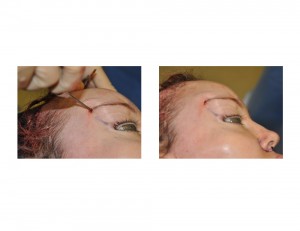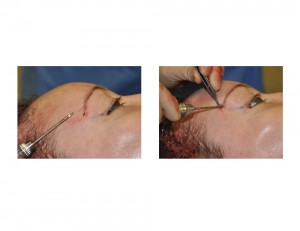Numerous browlift procedures exist to lift sagging brows and help rejuvenate an aging periorbital look. The success of most browlifts are based on a tissue release and a superior elevation of the sagging brows. Most techniques employ some form of fixation to the skull bone to hold the lifted forehead tissues as they heal. These have included a variety of metal and resorbable polymer devices that have taken the forms of pins, screws and platform style plates. They don’t have to hold the tissues very long as it has been shown that periosteal healing back to the bone in the new position takes about two weeks or less.
How much to elevate sagging brows and how to shape them as they are lifted is as much an art form as it is a science. How the brow arch gets shaped as it is lifted is affected by numerous factors such as incision and tissue fixation location as well as the amount of upward pull. What is known is that the shape of the shape of the brows and the amount they can be aesthetically lifted does differ significantly between women and men. Women can tolerate higher amounts of browlifting with an arch shape that is often preferred to be higher at the outer aspect than the inner brow area. Conversely, men can tolerate only a modest amount of browlifting and the arch shape should stay relatively flat. (unarched)
A few women do prefer a more dramatic browlift result which usually refers to a very high tail of the brow. This is often accompanied with a high outer corner of the eye lift as well. Such high tail of the brow positions can be difficult to achieve as they require a significant upward tissue lift and are almost always done best through a pretrichial or hairline incision to avoid backward displacement of the frontal hairline.

This direct brow fixation method is a useful adjunct to securing the outer tail of the brow in select cases. A direct browpexy may be necessary when a very high arch shape is desired amongst female patients.
Dr. Barry Eppley
Indianapolis, Indiana



